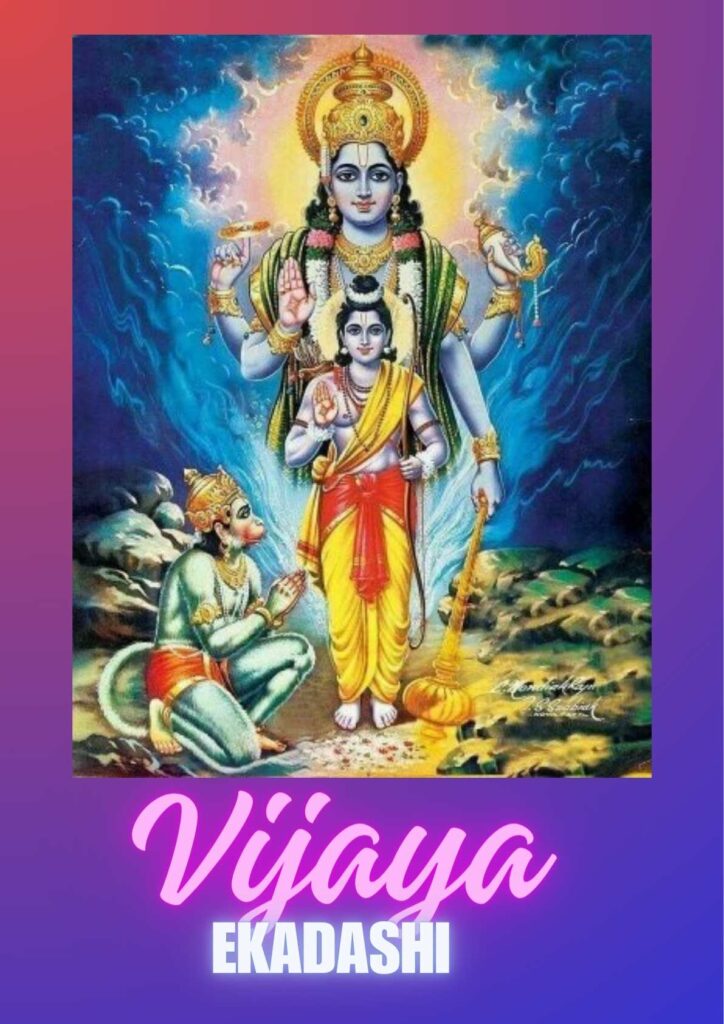
Ekadashi Tithi Begins: at 06:30 AM on Mar 06, 2024
Ekadashi Tithi Ends: at 04:13 AM on Mar 07, 2024
Parana Time –On 8th March, 06:38 AM to 09:00 AM
Note: “Parana” is the breaking of the fast. Ekadashi Parana is observed on the next day of Ekadashi fast after sunrise within Dwadashi Tithi.
On the Krishna Paksha of the Falgun month, the waning moon marks the auspicious occasion of Vijaya Ekadashi. True to its name, observing this Ekadashi fast diligently is believed to bestow victory upon individuals over their adversaries and challengers. Throughout history, numerous kings and rulers have emerged triumphant in fierce battles owing to the influence of this fast. References to the significance of Vijaya Ekadashi fasting can also be found in the Puranas. It is believed that even in dire circumstances, when one finds themselves surrounded by enemies, observing the fast of Vijaya Ekadashi can lead to triumph. Moreover, it is said that observing this fast grant liberation from suffering.
Vijaya Ekadashi Vrat Katha:
The narrative of Vijaya Ekadashi bears a resemblance to the tale of Vijaya Dashami, with Lord Shri Ram being central to the Vijaya Ekadashi narrative. According to the legend, during the Dwapar era, the Pandavas sought to understand the significance of Falgun Ekadashi, expressing their inquiries to Lord Krishna. In response, Lord Krishna revealed that Narad Muni was the first to learn about the importance of Falgun Krishna Ekadashi from Brahma, followed by the Pandavas as the subsequent recipients of this knowledge.
The story harks back to the Treta Yuga, when Lord Shri Ram embarked on a quest to rescue Mother Sita after her abduction by Ravana. However, his path was obstructed by the vast ocean, teeming with perilous sea creatures that posed a threat to his monkey army. In his human form, Lord Shri Ram sought a solution to this predicament. Advised by Lakshmana, they approached Sage Wakdalbhya Munivar, who resided nearby, for guidance.
Lord Shri Ram humbly presented his dilemma to the sage, who prescribed a solution: fasting on the Ekadashi of the Krishna Paksha of the Falgun month. This fast, observed by the entire army as directed by Muni Vakdalabhya, was believed to not only facilitate the crossing of the sea but also ensure victory in the conquest of Lanka. Following the sage’s counsel, Lord Shri Ram and his army fasted on Ekadashi, thereafter, launching a successful assault on Lanka. Despite being in human form, Lord Vishnu, incarnated as Lord Shri Ram, emerged triumphant over Ravana’s formidable army, ultimately liberating Mata Sita.
In today’s world, characterized by rampant selfishness, individuals embodying the selflessness of Lord Rama are indeed rare to find.
Vijaya Ekadashi 2024: Puja Vidhi and Rituals
1. Rise early on the morning of Ekadashi, bathe, and don clean attire before commencing the Ekadashi fast.
2. On Dashami, arrange an altar and position seven types of pulses, collectively known as sapta dhan (urad, moong, wheat, gram, barley, rice, and millet), upon it.
3. Craft an urn from gold, silver, or clay, as per your means, and place it atop the altar.
4. On Ekadashi day, adorn the urn with the idol of Shri Vishnu, embellishing it with Panch Pallav, comprising five leaves (Peepal, Gular, Ashok, Mango, and Vat).
5. Offer worship to Lord Vishnu with incense, lamps, sandalwood paste, flowers, fruits, and basil.
6. Throughout the day, immerse yourself in reading and listening to the tales of Lord Vishnu.
7. During the night, engage in vigil before the adorned urn.
8. On Dwadashi, present the urn to a Brahmin or Pandit as a donation.
9. Finally, on Dwadashi, conclude the Ekadashi fast by partaking in Saatvik food.